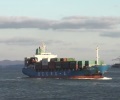

Singapore’s bunker fuel sales for the 380 CST HSFO grade fell to a one-year low in the world’s largest bunkering port in September amid limited cargo availability, while total marine fuel sales volume also dipped overall last month, reflecting weak bunker demand.
Bunker fuel sales of 380 CST HSFO in the city-port slipped 7.1% on the month in September to a one-year low of 908,000 mt, latest data by the Maritime and Port Authority, or MPA, of Singapore showed.
“Not all physical suppliers here [in Singapore] supply HSFO. Shipping bottlenecks and delayed vessel sailing schedules [in the Asian region] are also weighing on overall demand,” an industry source said.
Total marine fuel sales in Singapore slid 3.4% month on month and 6.7% on the year in September to 3.935 million mt.
Bucking the overall downtrend was sales of low sulfur (0.1%) marine gasoil, which was up 14.4% month on month at 331,700 mt, but 8.6% lower on the year, while 0.5%S marine gasoil sales rose 0.2% month on month to 26,800 mt, MPA data showed.
The tight supply of high sulfur fuel oil bunkers is expected to extend into November, while the scarce spot availability has also supported premiums of the delivered grade and turned buyers away from bunkering calls in Singapore, industry sources said.
So far in October, premiums of Singapore-delivered 380 CST HSFO against FOB Singapore 380 CST HSFO cargo assessments averaged $18.70/mt through Oct. 26, down from September’s average of $21.37/mt but above the average of $12.14/mt in August, S&P Global Platts data showed.
“HSFO inventory was relatively tighter in late-August through September, so Singapore HSFO ex-wharf term contractual premiums for balance-October supply has come off,” a Singapore-based bunker supplier said.
“However, most of the product is committed to supply the monthly and quarterly term contractual buyers of Singapore-delivered 380 CST HSFO than for spot demand,” he added.
According to market sources, the latest term contractual supply of Singapore ex-wharf 380 CST HSFO for balance October were done at $10-$11/mt over the FOB Singapore 380 CST HSFO cargo assessments in the second-half of October, down from premiums of $14-$18/mt for October supply inked between late-September to H1 October.
Initial discussions for November term supply of Singapore ex-wharf 380 CST HSFO indicated offers at around $8/mt, which also signaled a gradual easing of inventories, sources said.
“Although spot sales [of Singapore-delivered 380 CST HSFO] waned, demand for monthly and quarterly term contracts remain stable as it is imperative that shipowners secure prompt supply of HSFO bunkers,” a trader said.
Other ports ramp up HSFO supply
Ports in nearby India and Sri Lanka have seen a marked increase in inquiries and are trying to ramp up HSFO offers.
India’s Adani Bunkering earlier this month said it had started supplying high sulfur fuel oil in Mundra and other ports in Gujarat as the installation of scrubbers on ships showed positive prospects after the International Maritime Organization’s global low sulfur mandate.
The price differential between HSFO and 0.5%S marine fuel, known as the Hi-5 spread, has also favored the use of scrubbers.
The current scrubber fleet numbers about 4,500, but if clean alternative fuels do not achieve adequate penetration by 2030, this number could escalate to close to 7,000, Platts Analytics estimated recently.
In Singapore, the Hi-5 averaged $298.90/mt in January 2020 as the market transitioned to the IMO 2020 mandate. It narrowed to average as low as $60.32/mt in September 2020 but rose to average $103.33/mt in January 2021, according to Platts data.
For most of 2021, the spread has, on a monthly basis, averaged mostly over $100/mt, but fell slightly to an $95.3/mt average over Oct. 1-26, Platts data showed.
In Sri Lanka, Advantis Bunkering became the first supplier of delivered HSFO at Colombo port, banking on a long-term increase in calls by scrubber-fitted vessels, a company source said recently, with “multiple inquiries” from major shipping companies since launching delivered HSFO sales.
A physical bunker supplier with a substantial market share at the port of Colombo also told Platts recently that a plan to offer delivered HSFO is “currently in the works.”
Meanwhile, the industry source noted that barging and operational costs in Singapore had gone up “tremendously” due to competition amid tepid bunker demand.
Charter rates are quite high now, he said. While HSFO in ports in India and Sri Lanka may still be more expensive, shipowners could still decide to refuel HSFO there, when they look at overall costs, he added.
Source: Platts